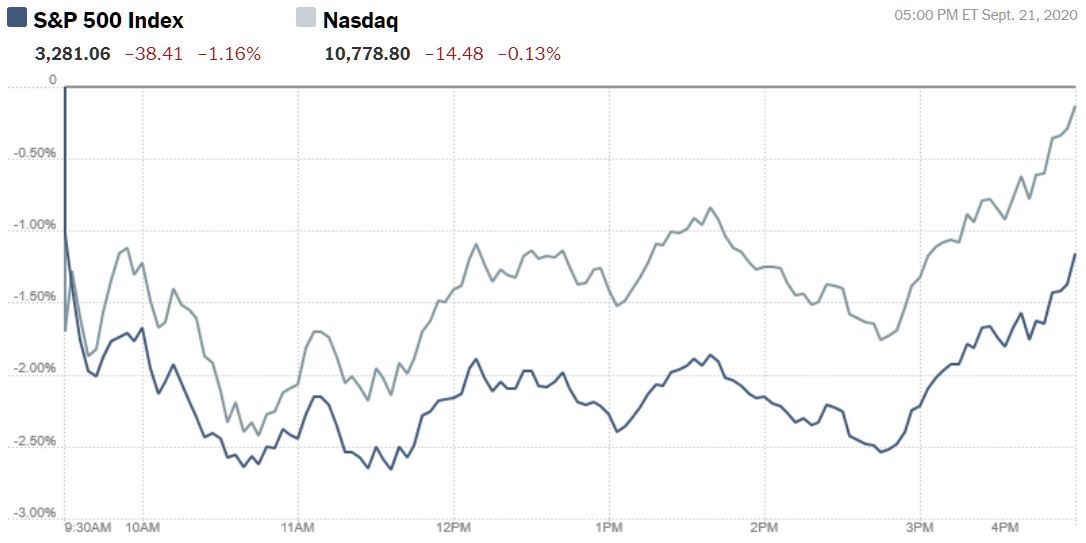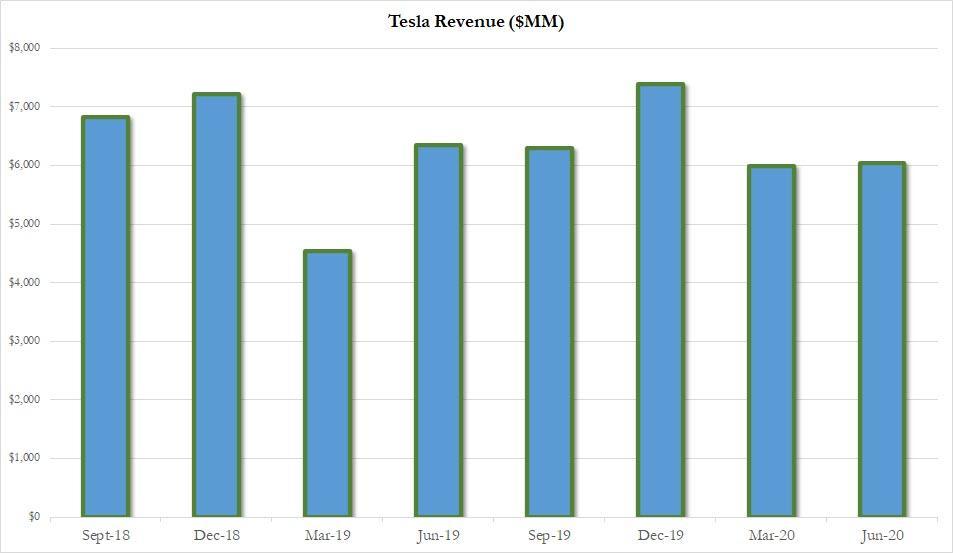TalkMarkets Tuesday Talk: Fall Is Here, You Can See It In The Leaves And In The Markets

Monday was the first day of Fall and the markets seemed to remind us that September is the worst month of the year for stocks on average. But remarkably, though there were sharp sell-offs throughout the day with markets ending lower, the Nasdaq recovered from it's mid-day low of -2.5% to close off just -.13% at 10,779, the Dow and the S&P 500 were down -1.8% and -1.2% respectively at 27,148 and 3,281. While concern over the worldwide resurgence of COVID-19, lack of a stimulus package from Congress, US-China relations (yes, that's a red panda in the picture) and rising partisan tensions over a Supreme Court nomination to replace Ruth Bader Ginsburg provided much of the backdrop for yesterday's continuing slide on Wall Street, stocks in Europe seem to be recovering somewhat today and US futures are currently flat: S&P +.14%, Dow -.10% and Nasdaq 100 +.52%. To put things in perspective below are the daily and yearly charts for the S&P and the Nasdaq:


Charts: The New York Times
A quick glance of the financial headlines finds some pundits saying we should look for the S&P to go to 3,100, the Dow to 26,000 and the Nasdaq to 10,000. Against this mis-en-scene, here's what's on the minds of a few TalkMarkets' contributors.
George Krum in Targets For The Week Of Sept. 21 has these remarks with regard to the S&P 500: " (Last week) we noted that for an up phase to take hold, the SPX needs to break above 3400. The SPX started the week by rallying but stalled at 3400, and after market breadth reached overbought levels on Wednesday, the sell-off resumed. As a result, the technical outlook (for this week) is negative, since both the weekly and the daily signals turned bearish, and market breadth needs a few more days to reach oversold levels. In summary, only support at 3300 stands in the way of lower prices, and only a break above 3400 will invalidate the bearish scenario.
Krum notes that, " both Goldman Sachs (GS) and JP Morgan (JPM) “see the SPX rallying to 3600 by year end”. In other words, they are betting on a resumption of the rally after the current sell-off ends, although it is not clear when and from what level they expect that to happen. Which begs the question: what is the purpose of giving upside targets without a corresponding downside target, and how to manage exposure, entry and exit levels, with just one price target? " Here is his chart which tries to do just that:

Jared Dillian thinks we should be wary of what we read and watch in his TalkMarkets Editor's Choice article, They're Just Messing With Us, Dillian, a veteran trader, has some good tales of headlines and crises past. It's a good read, one that will go well with your morning coffee, so no spoilers here, but just a bit about what he has to say about what is going on right now.
"In times like this, you want to buy things with a valuation cushion. Because if this really is the beginning of a bear market, valuations will compress. Yes, I am talking about value stocks. I’m comfortable making that prediction—value stocks are headed for a long period of outperformance over growth stocks. And that is the sort of prediction that would have you laughed off the set of CNBC."
In Economic Forecast 2022-23: Recovery From The Pandemic Recession, TalkMarkets contributor Bill Conerly notes that the forward looking forecast for the economy is based on what happens with regard to the pandemic and continued involvement in the economy by the Fed. He gives the following anchor points for his forecast:
-
We are imperfect people living in an imperfect world, doing the best we can. The economic forecast depends on the COVID-19 pandemic forecast. Around the world, the number of new cases identified has leveled off. That does not mean that illness is leveling off, but the growth rate is now steady.
-
Currently the economy lies in a middle ground, not locked down but not back to normal. We are waiting for a vaccine or effective treatment.
-
Right now the economy has rebounded partially. Employment fell by 22 million jobs from February to April, and has regained nine million of those jobs as of the August jobs report. Despite the continued high unemployment rate, though, retail sales have fully recovered. The V-shaped pattern is also reflected in home sales.
-
Busines spending on capital goods also recovered from a spring slump, though the outlook is a little soft moving forward.
-
Government spending has risen substantially, thanks to all of those stimulus payments. Automatic stabilizers and the increased saving from past stimulus payments will support the economy in the near term.
Conerly forecasts that as a result of this (his article has data and charts to support the above) we can expect the following in the short to mid-term:
"The economy will likely expand from the current depressed level at a moderate pace through summer 2021. About six months after a vaccine is approved, the economy should grow rapidly to regain all lost ground. During this recovery era, interest rates will remain low.
Thereafter, however, the economy is likely to destabilize, with the Fed over-tightening in response to inflation, then over-easing in response to the resulting recession, as described in my article about the Fed’s new strategy. This more-cyclical era won’t begin until 2022 or 2023, but it’s coming."
Reporting on the actual rough-and-tumble of the trading arena, Tyler Durden in Tesla Tumbles After Musk Pours Cold Water On Battery Day Expectations, vividly reminds us how fortunes can be made and lost in instants in his review of Monday's action in Tesla (TSLA). Here are some of the salient bits:
"After an initial drop on Monday that followed the broader market swoon, Tesla shares recovered all losses and even managed to close up 1.6% as enthusiasm over tomorrow's Battery Day unveil once again dominated retail flow with a whopping 33,152 deep out of the money $600 calls traded, sparking yet another gamma meltup as dealers were forced to buy stock to keep their book hedged."
"However, in a surprise announcement ahead of tomorrow's highly anticipated day, none other than Elon Musk sparked another round of selling after the close, when he poured cold water on expectations, warning that "what we announce [tomorrow] will not reach serious high-volume production until 2022" and adding that "even with our cell suppliers going at maximum speed, we still foresee significant shortages in 2022 & beyond unless we also take action ourselves."... The result: Tesla stock quickly dropped 30%, which while not nearly as aggressive as this morning's tumble, promptly wiped out as much as $42 billion in Tesla market cap, the equivalent of GM's entire market cap."
Durden notes that "while Musk remains an undisputed master when it comes to setting and missing expectations, the question once again emerges: at what point will Tesla do something to justify its "growth" status. Because one look at its revenues over the past two years certainly begs a simple question: where is the growth." Here's that chart:

Another, cautionary tale, for sure.
To counter some of this volatility take a look at Sweta Killa who in seeking out "investment refuge" finds some in four well followed ETFs. In 4 Safe ETF Bets As Global Stocks Tumble, Killa puts the following on offer:
1. Gold - SPDR Gold Trust ETF (GLD)
Gold is often viewed as a store of value and hedge against market turmoil. The product tracking this bullion like GLD could be an interesting pick in the current market turbulence. The fund tracks the price of gold bullion measured in U.S. dollars and is kept in London under the custody of HSBC Bank USA.
2. Long-Dated Treasury - iShares 20+ Year Treasury Bond ETF (TLT)
The products tracking the long end of the yield curve often provide a safe haven. TLT provides exposure to long-term Treasury bonds by tracking the ICE U.S. Treasury 20+ Year Bond Index.
3. Low Volatility - iShares MSCI Global Min Vol Factor ETF (ACWV)
These products have the potential to outpace the broader market, providing significant protection to the portfolio. These funds include more stable stocks that have experienced the least price movement in their portfolio.
4. Dividend - Global X SuperDividend ETF (SDIV)
The dividend-paying securities are the major sources of consistent income for investors when returns from the equity market are at risk. This is especially true as these stocks offer the best of both these worlds — safety in the form of payouts and stability in the form of mature companies that are less volatile to large swings in stock prices.
Caveat Emptor, of course.
As a no doubt further turbulent week awaits, I leave you with a bit of wisdom from Mark Twain.
"October: This is one of the peculiarly dangerous months to speculate in stocks. The others are July, January, September, April, November, May, March, June, December, August and February" Pudd'nhead Wilson




Certainly these are some tough times, with the fed bank not knowing what to do for the past few years, and yet doing it as fast as they can. And the markets being a bit down because of closures and also the folks dying from the plague going around. Since the market IS driven partly by emotions that is to be expected.
But the day after a solid cure becomes available or a good vaccine becomes commonly available for all, will be a day too late to buy because all of the stocks will take off.
For sure, a vaccine and viable treatment therapy is what is needed.